| Patriot Outreach Supporting all Military Service Men, Women, Retirees, Veterans, Government Civilians, Battlefield Contractors, First Responders and their Families (Patriots) |
| Home | My Story | Programs | What's Happening | About Stress & PTSD | News & Reports | Donate | Mission | Contact |
 40 Lessons Unlearned About War &
40 Lessons Unlearned About War & Its Impact: From Vietnam to Iraq.
Dr. Raymond M Scurfield, DSW, LCSW
Vietnam Veteran, author of A Vietnam Trilogy of books. (New York: Algora)
About Dr.Scurfield Current C.V.
Word Version
1. There are numerous myths and realities that are misunderstood about war and its impact; such myths have been around for decades and compound the post-war challenges facing Armed Forces Personnel and their Families (Scurfield, 2006b). These include:
- “Heroes and normal healthy persons do not have problems during or following a war.”
- “Time heals all wounds.”
- “I must be crazy or weak to still remember and be bothered by the war after all this time.”
- “If I can just forget the war, I can move ahead with my life.”
- ‘If I didn’t break down during combat, then I must be the problem if I am having difficulties months and years later.” (Reality: Soldiers rarely break down in the midst of battle; if they do break down, it happens later---days, weeks, months later---and so just because you seemed to get through the worst of it okay, doesn’t mean you will necessarily do okay later . . . )
2. Pro-war and pro-military advocates and politicians oftentimes are not pro-veteran adherents: this is because there always are extremely strong competing priority funding tensions between funding the existing war versus funding programs and benefits for Veterans---those who favor funding for expensive technology, weapons, etc., oftentimes are resistant to more funding for Veterans’ benefits, health and social programs.
3. The Secretary, U.S. Department of Veterans Affairs (VA), is a political appointee by the President. Hence, he/she typically is more responsive to current Administration policies (i.e., cutting the federal budget except for DoD funding) than being an ardent advocate for Veterans’ health, mental health and benefits needs.
4. Once again there is a paucity of coordination and collaboration between the DoD and the VA, with a prevailing DoD attitude that those who do not perform well can be discharged “for the VA to take care of.”
5. There is a remarkable angst created by having a Veterans’ benefits system that in effect financially rewards Veterans for having psychiatric disorders, and that punishes them financially if they improve significantly.
Indeed, the system in place literally requires that Veterans be given a psychiatric diagnosis to be eligible to receive financial and priority medical services. This is an extremely powerful dynamic that inevitably inflates the numbers of Veterans who are given and who maintain a PTSD diagnosis.
Tragically, the pressures to get and keep a PTSD diagnosis in order to qualify for and keep a service-connected disability rating are enormous and can lead to (a) distorting treatment outcomes and (b) labeling many Veterans with a PTSD or other psychiatric diagnosis who may have a normal and expectable response to war trauma.
6. Front-line Combat Forces always have been the cannon fodder during war. From the movie, Ulysses:
“War is young men dying and old men talking. It’s always been that way.”
7. Western countries continue to justify “conventional” warfare as being much more defensible than an enemy’s guerilla warfare or terrorist acts (Scurfield, 2002; Scurfield, Viola, Platoni & Colon, 2003).
Anyone who is a vilified terrorist in the eyes of one side is almost always seen as a heroic resistance fighter by the other side, fighting against overwhelming technological superiority and sophisticated and massive amounts of weaponry. Facing such an overwhelming force, of course the other side will resort to guerilla and/or terrorist acts.
8. For every enemy you kill in a guerilla war, you create (at least) two new ones (Galloway, 2006).
9. Occupying troops in any foreign land initially may be welcomed as liberators, but the longer they remain, they inevitably will become despised as foreign occupiers.
This is not a new phenomenon in Iraq. It has always been this way---throughout history.
10. The extent of the killing and maiming that occurs to the civilian populace in the country in which the U.S. is fighting almost never has any meaningful impact on the war policy or on funding decisions.
This devaluation of the loss of life among civilians in the country in which we are fighting is utilized to mask the intolerable realities of the full human costs of war. For example, estimates of the number of Vietnamese killed during the Vietnam War range from 2.4 to over 3 million—and some 300,000 are still unaccounted for. Was it worth it?
11. During a current war, governmental and military authorities inevitably issue highly optimistic reports that the mental health services for this war are unparalleled in our history and are doing a good job to minimize mental health casualties. Even when true, seldom is there mention that the acute psychiatric casualty rate has absolutely no relationship whatsoever to longer-term psychiatric rates.
12. Indeed, the acute psychiatric rate that occurs while in the war-zone and within the first several months following return from deployment always is less than the longer-term rate (see, for example, Solomon & Mikulincer, 2006). This lesson should give national policy makers great cause for concern that the Department of Veterans Affairs (the VA) requires significant funding and staffing to handle not only the needs of our Veterans today, but the even greater needs that are almost sure to come tomorrow.
13. Institutional factors contribute to under-reporting of mental health problems and concerns. Politicians and DoD officials will do this to hype how well the current war is progressing. And officials of the government, DoD and VA oftentimes appear more interested in attempting to minimize the truth about the full human impact of war by “blaming” the individual casualty for having war---and post-war related problems---rather than admitting the full extent to which war is the significant etiological factor.
14. War Veterans and their Families also contribute to the under-reporting of mental health concerns:
- Lack of trust to confide such to military mental health personnel.
- Fear of stigma or other negative reactions from unit command and peers.
- Fear of damage to one’s military career.
- The natural tendency for trauma survivors to deny to oneself one’s problems in an attempt to put them aside and move on with one’s life. And this can work for awhile.
- The military community is a tight-knit milieu that offers support, resources and camaraderie for both military personnel and their families that simply are just not available after being discharged from active duty.
- The military community reinforces the “suck-it-up, soldier-on, deal-with-it” mentality to suppress any mental health issues and/or not admit them to anyone.
- Family members and friends also want and typically tell the Veteran to “just forget about the war and move ahead with your life. You shouldn’t be bothered by this after all these months (years).”
5. Various studies of Veterans from Vietnam onward reveal that 15% to over 30% of war Veterans suffer PTSD and/or other major psychiatric problems sometime during and/or following their return from deployment. This appears to be the human cost of war on Americans---regardless of the war (i.e., Hoge et al, 2006; Kulka et al, 1990; Seal et al, 2007; Solomon & Mikulincer, 2006).
16. Numerous studies dating from WW II onward clearly document a direct linear relationship between the amount of exposure to combat stressors and the likelihood of eventually developing post-traumatic stress (PTS) and mental health problems (i.e., Kulka, 1990; Cozza, 2003). Thus, military personnel whose tours of duty in the war-zone are extended or who are sent back for two or more additional tours in the war-zone are at high risk to eventually develop PTS, as are Troops wounded in a war zone. However, our Military Personnel and their Families are rarely if ever told this truth.
This linear relationship between exposure and mental health problems was confirmed recently by the third Army mental health survey of Iraq veterans---see Wood, 2006: Soldiers serving a repeat deployment reported higher acute stress than those on their first deployment. (See also Seal et al, 2007, that found younger age and length of deployment as risk factors.)
17. Initial euphoria and adulation paid to our Armed Forces inevitably dissipate and many Troops will move on to become very proud and/or perhaps very invisible, lonely and isolated Veterans of One. Indeed,
“Our government sends us to war, the military uses us in war, and society forgets us after war.”
18. For a substantial number of war Veterans, the negative impact of war trauma exists for decades:
- Trauma is literally unforgettable, and so it is useless and counterproductive to encourage or attempt to focus on “helping the Veteran to forget” the trauma. (See Platoni, 2006 for first-person account of Iraq war zone trauma.)
- Many PTSD symptoms actually are also functional ways to survive in a war-zone, and many vets do not want to let them go, as these behaviors may be perceived as conducive to post-war survival back home, i.e.:
--detaching from one’s emotions
--denying or minimizing the horror of war and what one is seeing and experiencing
--hyper-vigilance and exaggerated startle response - The profound memories, both the positives and the negatives that are the legacy of war, are ingrained into the Veterans’ psyche. I have written about this (Scurfield, 2004) as a “combat cocktail” in which both remarkable “highs” and devastating lows are inextricably enmeshed together. Thus, many vets are resistant to let go of the negative memories and impact because they cannot separate such out from the remarkable positives of the war and military experience—the adrenaline rush, the thrills, the sense of power, comradeship bonded in war.
19. A current war always has a significant impact on many veterans of previous wars and hence on resources, i.e. old psychological war wounds can be torn asunder and exacerbated (alternatively, there might be renewed pride and determination that our current Armed Forces will be treated fairly and with full respect and support).
20. In longer-term studies of aging Veterans of WW II, Korea and Vietnam, a substantial minority of Veterans has been found whose PTSD symptoms not only persist over decades but are exacerbated and worsen (i.e., Archibald & Tuddenham, 1965; Solomon & Mulciner).
This seems to be associated with such factors as:
- Loss of employment and/or retirement.
- Increasing health problems.
- Increasing frequency of deaths among family and friends.
- Issues that may arise or reappear related to the war, such as spiritual/religious, that are triggered by the impending ending-of-life on this planet
21. There is absolutely no evidence that the military medical mission to “conserve the fighting strength,” the practice to medically evacuate psychiatric casualties out of a war-zone “only as a last resort” and to return them to duty ASAP, have any relationship to positive longer-term mental health of the psychiatric casualty.
Everything in the war-zone drives the decision to return a psychiatric casualty to combat. This is understandable from the military medical mission. However, what is not clearly communicated is that this does not necessarily mean that this will be in the best interests of the individual psychiatric casualty. Indeed, the practice to return almost all psychiatric casualties to their duty stations ASAP obviously results in their facing yet additional and recurring trauma and thus becoming even higher risks of developing PTSD.
22. Medical evacuees from a war-zone face a host of stressful and traumatic experiences from the moment they are wounded or hurt in the war-zone until long after they are returned stateside (Scurfield, 2006a).
Most of these experiences are not talked about or adequately addressed---a conspiracy of silence about additional traumas and stressors that many of the wounded experience, i.e., what happened:
- right after being wounded and while still in harm’s way at the immediate scene
- during medical evacuation transport from one site to another
- while hospitalized alongside many others who were in worse condition, or who died
- while receiving treatment from some medical personnel who may have been insensitive to emotional issues
- were not being told honestly or completely about one’s medical condition—or lied to
- with family members’ reactions who could not handle emotionally what happened to their loved ones
- when confronted with negative or non-sensitive remarks from others back home, i.e., “it’s a shame that you had to loose your legs for nothing”
23. What is reinforced by military training and by military mental health practices in a war-zone are such strategies as denial, suppression, avoidance, minimizing of significant problematic emotions or issues. Unfortunately, these very same strategies too often are the source of significant problems when trying to readjust to civilian life if the veteran cannot let them go to a considerable degree---and too many cannot.
24. The military spends only a fraction of the time and effort to help military personnel return from war and “unlearn” being a war-zone combatant---in great contrast to the time and effort that goes into turning military personnel into combatants. The minimal attention to deconditioning is critical in that the common strategies used to prepare one to kill and survive while deployed in a war have corresponding and potentially very negative impacts after returning from deployment. (See “Battlemind Training 1, Transitioning from Combat to Home” for one approach at such deconditioning).
By and large, returning military personnel are left to “unlearn” such conditioning on their own (Platoni, 2007), i.e.:
- Conditioning military personnel to dehumanize the enemy---to see and treat the enemy not as human beings like we are but rather to denigrate them, treat them as less than human; and racist attitudes and behaviors are central to such dehumanization. And this can be brought home into one’s relationships with others.
- Teaching and reinforcing expertise in numbing of one’s emotions, denial of the reality of what is going on, avoiding underlying painful emotions, etc. And this can be brought home, with the veteran having extreme difficulty being emotionally accessible even to family members or is not able to be in touch with one’s own emotions.
- Facilitating and encouraging the discharging of one’s anger through violence onto the enemy. And this can be brought home as what happens when one becomes angry or enraged---taking it out physically on others; for other returned veterans, there is extreme preoccupation that one will lose control and become violent again, like during the war.
25. Key issues facing a number of Armed Forces personnel that have too little if any attention paid to them in military or civilian mental health assessments or interventions include (a) racism towards the enemy, civilian population and between Americans (Scurfield & Mackey, 2001; Loo et al, 2001), (b) sexism and gender-based trauma, and (c) homophobia (Scurfield, 2006b,c).
26. There are serious problems with the validity and usages of a PTSD diagnosis in terms of being able to differentiate between a “normal” or “expectable” response to trauma versus a “disordered” response. This is particularly so for the trauma of war.
- Thus, military officials refer to “combat stress reaction” and not “PTSD” for the vast majority of psychiatric casualties in a war.
- What is “normal” and “expected” for veterans to present days, months, years and decades later after being in a war, versus what indicates a “disordered” response-set?
- Indeed, some of the core psychiatric symptoms of PTSD as defined by the American Psychiatric Association also are very common and extremely important and functional methods of survival in a war-zone, e.g.,
-Detaching from or numbing one’s emotions
-Denying or minimizing the horror of what one is seeing and experiencing
-Hyper-vigilance
-Exaggerated startle response
-Experiencing the environment as unreal (see Scurfield, 2006b)
27. Military veterans inevitably accept an exaggerated degree of responsibility for every trauma involving them that occurred in the war-zone—versus when a democratic nation goes to war, should not every citizen of voting age bear a share of the responsibility for all that happens during the war? (See Scurfield, 2006b, for description of the “determining the percentages of responsibility” technique to address such issues.)
28. Core PTSD mental health assessment and treatment interventions almost never significantly address a core issue of vets—their relationship with their country, their government, and their communities. And when the nation is experienced or perceived by our veterans as having forgotten them and their sacrifices and the sacrifices of their families, this is experienced as a profound betrayal (Scurfield, 2006b, 2007a)
And so, one of the worst experiences that is most hurtful to veterans:
- to “be forgotten” or put at the bottom of the nation’s priority list when providing resources
29. Two other experiences most hurtful to veterans:
- to be told, or to tell yourself, that your sacrifices and those of your comrades-in-arms, were for nothing
- to be denigrated, demeaned, dishonored for your military service
30. Politicians, military officials and current active duty personnel all tend to emphasize how different and unique the current war is. This emphasis is used to invalidate appreciation of the lessons learned from prior wars that are still applicable today and obscures the remarkably powerful universal aspects of all wars.
31. There is a singularly universal source of traumatic impact on combatants:
Our country sends us into harm's way and sanctions us to be perpetrators to kill and maim when necessary, and to be killed and maimed, and to put our comrades at risk for the same, and to put civilians in the country in which we are waging war at the same risk. And it is what men and women have to do to be able to function and survive day-after-day, week-after-week, month-after-month and perhaps year-after-year in such a milieu that is brought home and into the families and into our communities.
Typical traumatic combat-related incidents that are salient for such experiences include: (a) being wounded; (b) witnessing comrades-in-arms being maimed or killed; (c) feeling somehow responsible for the deaths of maiming of fellow and sister comrades-in-arms; and (c) being involved in the “unnecessary” or “mistaken” killing and maiming of civilians, especially women, children and elderly.
32. For a number of troops, exposure to one or two singularly traumatic experiences, regardless of how long deployed, can be deeply impactful for years or decades. Indeed, even when vets are exposed to innumerable tragic events in the war zone, almost always there are one or two singularly impactful experiences that stand out above all the rest. And it is uncovering and fully addressing those one or two singularly traumatic events that oftentimes are the key to healing from unresolved war-related issues (Scurfield, 2007b).
33. There is the widely held and mistaken belief that warriors in battle are fighting primarily for their country. Wrong. For many combatants, they are fighting primarily for their comrades-in-arms and for their own survival. In the heat of war and battle, nothing matters more—and for a number of combatants, the welfare of their buddies is paramount, even more so than their own welfare. Hence, dynamics and issues within small-unit relationships are infused in the trauma of war and must be addressed in healing.
34. “Politics” and political issues always are extremely important dynamics and stressors that deeply impact on combatants and veterans and hence, need to be an integral element and subject of mental health intervention. Is the country united or divided about the current war? If divided, what is the impact of debates and criticisms “pro-this-war” and “anti-this-war” on our troops and their families during the war and afterwards? (Because there always is an impact.)
35. And the troops themselves always have deeply held political convictions about the rightness or not of this current war. The ramifications on healing are enormous. If a combatant believes strongly in the merits and moral rightness of this war, that belief can help to sustain oneself through the horrors exposed to and committed. Conversely, if while deployed or sometime after deployment one is or becomes against this war or is extremely ambivalent about its rightness, this can be devastating to one’s own rationalizations about how the combatant feels about what had to be done to survive. Such issues must be addressed (Scurfield, 2007b).
36. An essential element to address as part of the post-war healing process: there is a sacred covenant that society and our military pledge to each other:
Military personnel are willing to go into harm’s way, maim and kill human beings, and put themselves and their buddies at great risk, on behalf of our country. In return, our country agrees to honor and remember our military’s sacrifices and to provide varying health, educational and other benefits. And then, if and when these are perceived or experienced by veterans as broken promises, the sacred covenant may be broken and Veterans can feel totally betrayed. The result is devastating and alienating to many Veterans . . .
(see “The expanding circle of healing” in Scurfield, 2006b.)
37. Our country, especially the VA, provides extremely minimal services for the partners and children of Veterans, e.g., VA work-load credit received is extremely minimal for services to family members.
38. There are over 20 important “do’s” and “don’ts” about how to interact with someone who has returned from deployment to a war-zone. Unfortunately, family members oftentimes learn these only through needless trial and error---or are never learned. And yet these have been experienced following all wars.
Family members have the right to be educated about such do’s and don’ts, and our government has the responsibility to see that they are, before Veterans return from deployment (see Scurfield, 2006b) and Lyons, 2007), i.e.,
- Never tell a Veteran that “you understand” what he/she went through during war—or afterwards.
- Do not say, “Did you kill anybody?”
- Do not take it personally when your Veteran does not want to talk about the war with you, or about what he/she is going through now.
- Be familiar with and aware of warning signs in your Vet.
- Do not ignore your own wants and needs.
- Do put your own oxygen mask on first. You cannot be of adequate support and help for your veteran if you don’t.
- Do not be a Lone Ranger---seek out support groups, Vet Centers or other sources of assistance.
39. Returning decades later to a land in which a Veteran fought can provide post-war healing opportunities not otherwise available (Scurfield et al, 2003, Scurfield, 2004, 2006a regarding healing trips to Vietnam).
40. For every negative legacy that a Veteran brings home after the war, there is a countervailing and potential positive aspect---and vice-versa (Scurfield, 2006c), i.e.:
- “Nothing means nothing anymore”
versus
“A clearer sense of priorities—what is really important now”
- “Disturbing loss of trust and loss of faith in our nation’s institutions”
versus
“Development of a very healthy questioning of the motivations and behaviors of those institutions”
- “I must be crazy to still remember and be bothered by . . . that happened so many years ago . . . ”
versus
“It is a sign of health not to forget and remember what should be remembered about it. And if you and I don’t remember, brother and sister veterans and family members, who will?”
What are other lessons unlearned about war and its impact that you might be aware of?
REFERENCES
Archibald, H.C. & Tuddenham, R.D. (1965, May). “Persistent stress reaction after combat. A 20-year follow-up.” Archives of General Psychiatry, 12: 475-481.
Cozza, S.J. (2005). “Combat exposure and PTSD.” PTSD Research Quarterly, 16 (1), 1-7.
Galloway, J. (2004, September 18). “War in Iraq: It’s got to be about more than numbers.” www.sunherald, Biloxi, MS, C2.
Hoge, C., J. Auchterlonia & C.S. Milliken. (2006). “Mental health problems, use of mental health services, and attrition from military services after returning from Iraq and Afghanistan. JAMA, 295 (9), 1023-1032
Kulka, R.A., W.E. Schlenger, J.A. Fairbank, R.L. Hough, B.K. Jordan, C.R. Marmar & D.S. Weiss (1990). Trauma and the Vietnam War Generation. Report of Findings from the National Vietnam Veterans Readjustment Study (NY: Brunner/Mazel).
Loo, C., Fairbank, J., Scurfield, R., Ruch, L., King, D., Adams, L. & Chemtob, C. (2001). Measuring exposure to racism: Development and validation of a race-related stressor scale (RRSS) for Asian American Vietnam veterans. Psychological Assessment, Vol. 13 (4), 503-520.
Lyons, Judith (1997). “The returning warrior: Advice for families and friends.” In C.R. Figley & W.P. Nash (Eds.) (311-324), Combat Stress Injury. Theory, Research and Management (New York: Routledge). Platoni, K. (2006). The War Room. http://cism-southwestohio.org/2006op4.pdf.
Platoni, K. (2007). Warning signs, triggers and coping strategies for veterans of Operation Iraqi Freedom. Powerpoint. . Accessible on-line at Patriot Outreach. (Adapted from Scurfield, R.M. War Trauma, 2006).
Scurfield, R.M., Viola, J. Platoni, K. & Colon, J (2003, March). Continuing psychological aftermath of 9/11: a POPPA experience and critical incident stress debriefing revisited. [POPPA = Police Officers Providing Peer Assistance]. Traumatology: The International Journal of Innovations, Vol. 9 (1), 4-30.
Scurfield, R.M. & Mackey, D. (2001). Racism, trauma and positive aspects of exposure to race-related experiences: Assessment and treatment implications. Journal of Ethnic & Cultural Diversity in Social Work, 10 (2), 23-47.
Scurfield, RM., Root, L., Wiest, A., Coiro, FN, Sartin, HJ, Jones, CL & Fanugao, MB. (2003, Fall). History lived and learned: Students and Vietnam veterans in an integrative study abroad course. Frontiers: The Interdisciplinary Journal of Study Abroad., Vol. IX: 111-138.
Scurfield, R.M. (1992). The collusion of sanitization and silence about war: One aftermath of Operation Desert Storm. Journal of Traumatic Stress, Vol. 5, #3, 505-512.
Scurfield, R.M.(2002, January). Commentary about the terrorist acts of September 11, 2001: Posttraumatic reactions and related social and policy issues. Trauma, Violence & Abuse, Vol. 3 (1), 3-14.
Scurfield, R.M. (2004). A Vietnam Trilogy: 1968, 1989 & 2000. Veterans and Post-Traumatic Stress. (New York: Algora Publishing)
Scurfield, R.M. (2006). War Trauma: Lessons Unlearned From Vietnam to Iraq. Volume 3 of A Vietnam Trilogy (New York: Algora Publishing).
Scurfield, R.M. (2006). Healing Journeys: Study Abroad with Vietnam Veterans. Volume 2 of A Vietnam Trilogy (New York: Algora Publishing).
Scurfield, R.M. (2007a, March 11). “Military problems go beyond Walter Reed Army Medical Center.” Hattiesburgamerican.com.
Scurfield, R.M. (2007b). “PTSD/Combat Operational Stress.” Presentation at the national U.S. Navy “War Time
Deployment Support Conference,” sponsored by Commander, Navy Installations Command, Family Readiness Programs. San Diego, CA. August 30, 2007.
Seal, K.H., D. Bertenthal, C.R. Miner, S. Saunak & C. Marmar (2007). “Mental Health Disorders Among 103,788 US Veterans Returning From Iraq and Afghanistan Seen at Department of Veterans Affairs Facilities.” Arch Intern Med.167: 476-482.
Solomon, Z & Mikulincer, M. (2006, April). Trajectories of PTSD: a 20-year longitudinal study. Am J Psychiatri, 163 (4), 659-66.
Wood, Sara. American Forces Press Service (2006, December 19). “Army releases results of third soldier mental health survey.” News & Commentary Military News. Accessed on TheConservativeVoice.com.
END
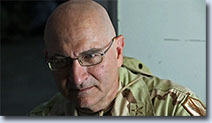 My Testimonial COL Antonio P. Monaco |
| Featured Articles |
The Real Cost of the War A special report: Why is the U.S. ignoring battle-scarred soldiers?  Warning Signs, Triggers and Coping Strategies Warning Signs, Triggers and Coping Strategiesby COL Kathy Platoni (Psy.D.), 307th Medical Group |
| Guidelines and Materials |
 Guidelines for Guidelines for Vets' Families Important advice for families of Veterans to help them cope and overcome stress. |
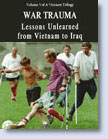 War Trauma: Lessons Unlearned from Vietnam to Iraq War Trauma: Lessons Unlearned from Vietnam to Iraqby Dr. Raymond M. Scurfield, DSW, LCSW Order the Book |
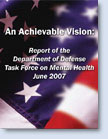 Task Force On Mental Health Report Task Force On Mental Health Report Department of Defense PDF Format |
| Support |
 God Bless the USA God Bless the USA Special Video Feature |
 Reason & Emotion Reason & EmotionEnjoy a Walt Disney Classic! |
 LifeLine Resources LifeLine ResourcesBest Online Support |
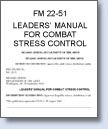 FM 22-51 FM 22-51 Leaders' Manual for Combat Stress Control |
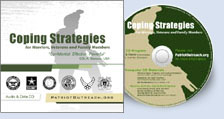 Coping StrategiesTM A special Multi-Media CD - an offline version of the PatriotOutreach website |
 Freedom FreedomA touching video about why we honor, cherish and celebrate freedom. |
 Sounding Off! Sounding Off!Listen in! and, discover more insights, news and feedback. |
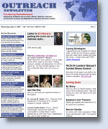 Outreach Newsletter Outreach Newsletter Sign up for the debut issue the Patriot Outreach email Newsletter. FREE |
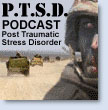 PTSD Podcast PTSD Podcast(Coming Soon) Get answers, help and news about stress, PTSD and Vets' issues. |
 Brainwashing Booklet Brainwashing BookletPrepare to be shocked! Explore the secrets and history of mass mind control. |
Write to us at: Patriot Outreach, 816 North Main Street, Suite 126, Lansing, KS, 66043
or
Call Toll Free: 1-866-96-STRONG (866-967-8766) (8am to 4pm Pacific Time) Email: info@PatriotOutreach.org
Copyright 2006-2014 Patriot Outreach
